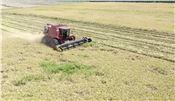Late Summer Rains Dampen 2022 Rice Harvest
DEREK ALBERT
CROWLEY, LOUISIANA
Louisiana rice farmers are certainly having a sense of deja vu as this year’s harvest comes to a close, as they’ve seen consistent, near- daily rainfall that has hampered their operations.
In the spring of 2021, steady rains caused farmers to have to delay planting rice, fertilizing fields and applying other chemicals. Mid-to- late August 2022 brought a similar weather pattern that dampened the harvest, rutted the fields and has, thus far, hampered second-crop cultivation.
The challenges farmers already faced with record-high input costs this year were compounded by soggy yields and rutted fields as the 2022 rice harvest ended on a wet note.
LSU AgCenter rice specialist Ronnie Levy said the harvest started off with optimism. Particularly in south Louisiana, a warm, sun-drenched growing season with adequate — if not copious — rainfall provided the optimal conditions for grain production. Fast forward to the harvest. Levy said when the combines first started rolling, yield data were producing strong numbers.
“Most of the yields were extremely good in the early part of the harvest,” Levy recalled.
Then, as the calendar progressed through mid-August, the skies opened up. The heavy winds and constant rains contributed to lodging, which was aided by the substantial crop that the growing season produced.
“With that lodging, it makes it a lot harder and slower to harvest the crop,” Levy said.
A lot slower indeed. Acadia Parish producer Donald Leonards said while it usually takes about two weeks to harvest his 700-acre crop, this year that stretched out to 33 days.
“The wet weather slowed the harvest to a crawl,” said Leonards.
“We couldn’t get the amount of rice out that we needed in a timely fashion. The logistics of getting equipment in and out became a severe problem. It was a fight from the beginning to the end.”
Leonards said the less-than-desirable harvest conditions only compounded the strife that he and other rice farmers were already feeling from producing a crop with record-breaking input costs.
“In the 27 years I’ve been farming, this has been the most expensive crop,” Leonards said reflectively. “Then, we have a hampered harvest. All that weighs on your mind. It takes a toll on you. You want to provide a good, quality product, but it’s hard when Mother Nature fights against you.”
Further west near the Calcasieu-Cameron Parish line, producer Brandon Vail recalls the muddy conditions causing logistical problems for his operation as well. He said getting trucks to the fields and the dryer bins became a headache with no cure.
“Normally, where we would be running a quarter mile with a cart, we were running three-quarters of a mile in a lot of places,” Vail said.
“And that’s not to mention that instead of cutting four or five loads, you’re cutting three.”
Despite the challenges the rainfall caused – or compounded – Vail offered a rather optimistic way of looking at the August precipitation.
“At least it’s not a hurricane. That’s all you can tell yourself,” he said with a restrained chuckle. “It’s just rainfall. It is stressful, but it’s not as stressful as trying to cut ahead of a tropical storm or hurricane where you know you are going to lose the crop entirely.”
Farmers in northeast Louisiana are still harvesting as they typically get a little later start with planting each year due to lingering colder spring temperatures. Tensas Parish AgCenter extension agent Dennis Burns said northeast Louisiana rice acreage was down for a second consecutive year because of the elevated price of soybeans.
Those farmers who did plant rice in the shadows of the Mississippi River bluffs are seeing similar conditions to what their southernmost counterparts were seeing.
“We were just getting started when the rains came,” Burns said.
“It’s been a mess trying to get the rice out. It rains somewhere in the parish almost every day.”
Once the north Louisiana crop is harvested, and the south Louisiana ratoon rice yields are added, Levy said there will be a more complete picture of how much rice was produced this year. ∆
DEREK ALBERT: LSU AgCenter

The combines rolled with wet tires through a soggy field during this year’s rice harvest at the H. Rouse Caffey Rice Research Station in Crowley. Research farm manager Brent Theunissen said persistent summer rains added to increased disease pressure, which hurt yield figures at the station.
Photo by Craig Gautreaux/LSU AgCenter

Rutted fields are seen throughout the Louisiana rice belt. The harvest’s soggy finale will have farmers using extra resources to repair those fields for subsequent crops.

Louisiana rice growers were stalled by late summer rains as the 2022 harvest was coming to a close. LSU AgCenter rice specialist Ronnie Levy awaits the final fields to be harvested to tally up what could still turn out to be decent yields.